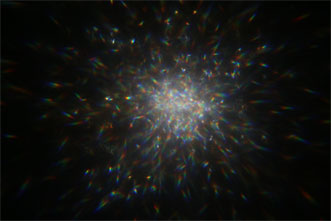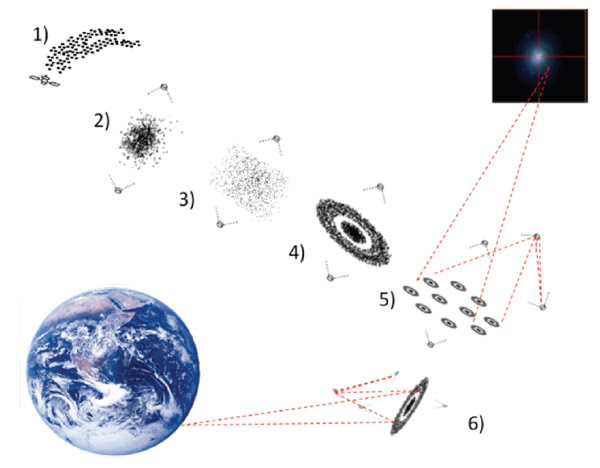This article accompanies the Feb. 11, 2015, episode of “Light Matters,” which focuses on the Orbiting Rainbows space telescope project. If you haven’t already, check it out at here.
Below are some additional details that, though fascinating, didn’t make it into the show script. There are also links to several papers and reports on Orbiting Rainbows and the optics concepts behind it. Enjoy, and don’t forget to comment and share!

Light is scattered by glitter during a deconvolution experiment in Swartzlander’s lab. Courtesy of Xiaopeng Peng/Rochester Institute of Technology.
Optical lift
Professor Dr. Grover Swartzlander of the Rochester Institute of Technology developed the concept of optical lift and published the first paper on the topic in 2010 in Nature Communications (doi: 10.1038/nphoton.2010.266).
“Light possesses a small amount of momentum,” Swartzlander told me, “and you can transfer that momentum to particles by reflecting or refracting the light.”
Light’s momentum has been exploited in a number of ways, Swartzlander said, from helping to control the altitude of satellites to optical tweezers, a technique for manipulating cells and other microscopic objects with lasers.
Optical lift is related to optical momentum: A properly shaped optical wing will not only be pushed away from a light source, it will also move in a perpendicular direction, like an airplane lifting off the ground as it heads into the wind.
In 2013, Swartzlander received a three-year, $325,000 National Science Foundation grant for further research on optical lift.
One of his co-authors on that foundational paper from 2010, doctoral candidate Alexandra Artusio-Glimpse, is also conducting research on optical lift under a three-year, $30,000 NSF graduate research fellowship awarded in 2012. You can find links to her work on optical wings and solar sails on her Google Scholar page.
Image manipulation
Dr. Joseph Mait of the U.S. Army Research Laboratory, who I turned to for a primer on computational imaging, has used the technique in experiments to artificially extend the depth of focus of an imaging system.
Conventional optics allow a wide depth of focus only with a narrow aperture. The trade-off is that the camera takes in less light and produces a dimmer image. But if one were to deliberately “screw up” the optics, Mait said, a bright image with a large depth of focus could be extracted through the use of signal processing.
In 2003, Mait co-wrote an overview article on computational imaging methods for Optics Express (doi: 10.1364/OE.11.002093 [open access]). In their conclusion the authors envision dynamic systems that use “feedback and adaptive elements” to achieve imaging goals.
So far, the computational and adaptive optics techniques Mait and I talked about have really only been in play in high-tech fields. But some day they could come down to Earth.
“People are thinking of doing the same thing with the eyeball,” Mait told me. Adaptive optics devices could help people maintain visual acuity as they age, or even as their eyes get tired over the course of the day.
Orbit
It’s still an open question exactly where the Orbiting Rainbows telescope would be positioned relative to the Earth.
“There are orbital environments that are more benign than others that we are considering for this type of application,” said Dr. Marco Quadrelli of NASA’s Jet Propulsion Laboratory.
His team currently is looking into parking the telescope at a Lagrangen point, one of the spots between the Earth and the Moon where the two bodies’ gravitational pulls are perfectly balanced. Meanwhile, the simulation Quadrelli provided for us to use on “Light Matters” assumes a geostationary orbit.
In either case, a giant shade might be necessary to protect the telescope from the sun’s rays.
Ruled out is low-Earth orbit, where the planet’s gravitational harmonics would make it difficult to keep the components of the telescope in formation.
Funding
In addition to the NSF grants related to optical lift research, Orbiting Rainbows has received more than $500,000 in funding from NASA’s Innovative Advanced Concepts program, according to Quadrelli.
Even more
Two extremely detailed reports on Orbiting Rainbows are available online. “Dynamics and Control of a Disordered System in Space,” by Quadrelli and Dr. Scott Basinger, supervisor of the Wavefront Sensing and Control group at JPL, was released last year.
A 143-page report on detailing Phase I of the project was released in 2013.

This “notional mission scenario” shows how Orbiting Rainbows would be deployed in space. 1) A cloud of optical wings is released. 2) The cloud is contained by laser pressure to avoid dissipation and disruption by gravitational tidal forces. 3) It is shaped by optical manipulation into a two-dimensional object (coarse control). 4) It is further shaped into a surface with adaptable imaging characteristics (fine control). The system could also be shaped into multilens configurations to search for exoplanets 5), or act as a radio receiver for remote sensing 6). Courtesy of JPL.